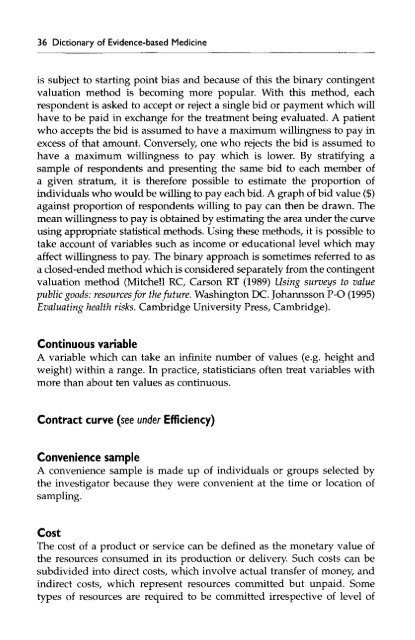Dictionary of Evidence-based Medicine.pdf
Dictionary of Evidence-based Medicine.pdf
Dictionary of Evidence-based Medicine.pdf
You also want an ePaper? Increase the reach of your titles
YUMPU automatically turns print PDFs into web optimized ePapers that Google loves.
36 <strong>Dictionary</strong> <strong>of</strong> <strong>Evidence</strong>-<strong>based</strong> <strong>Medicine</strong><br />
is subject to starting point bias and because <strong>of</strong> this the binary contingent<br />
valuation method is becoming more popular. With this method, each<br />
respondent is asked to accept or reject a single bid or payment which will<br />
have to be paid in exchange for the treatment being evaluated. A patient<br />
who accepts the bid is assumed to have a maximum willingness to pay in<br />
excess <strong>of</strong> that amount. Conversely, one who rejects the bid is assumed to<br />
have a maximum willingness to pay which is lower. By stratifying a<br />
sample <strong>of</strong> respondents and presenting the same bid to each member <strong>of</strong><br />
a given stratum, it is therefore possible to estimate the proportion <strong>of</strong><br />
individuals who would be willing to pay each bid. A graph <strong>of</strong> bid value ($)<br />
against proportion <strong>of</strong> respondents willing to pay can then be drawn. The<br />
mean willingness to pay is obtained by estimating the area under the curve<br />
using appropriate statistical methods. Using these methods, it is possible to<br />
take account <strong>of</strong> variables such as income or educational level which may<br />
affect willingness to pay. The binary approach is sometimes referred to as<br />
a closed-ended method which is considered separately from the contingent<br />
valuation method (Mitchell RC, Carson RT (1989) Using surveys to value<br />
public goods: resources for the future. Washington DC. Johannsson P-O (1995)<br />
Evaluating health risks. Cambridge University Press, Cambridge).<br />
Continuous variable<br />
A variable which can take an infinite number <strong>of</strong> values (e.g. height and<br />
weight) within a range. In practice, statisticians <strong>of</strong>ten treat variables with<br />
more than about ten values as continuous.<br />
Contract curve (see under Efficiency)<br />
Convenience sample<br />
A convenience sample is made up <strong>of</strong> individuals or groups selected by<br />
the investigator because they were convenient at the time or location <strong>of</strong><br />
sampling.<br />
Cost<br />
The cost <strong>of</strong> a product or service can be defined as the monetary value <strong>of</strong><br />
the resources consumed in its production or delivery. Such costs can be<br />
subdivided into direct costs, which involve actual transfer <strong>of</strong> money, and<br />
indirect costs, which represent resources committed but unpaid. Some<br />
types <strong>of</strong> resources are required to be committed irrespective <strong>of</strong> level <strong>of</strong>










